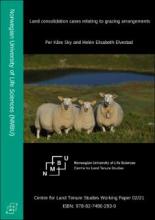Land Library
Bienvenue dans la bibliothèque du Land Portal. Explorez notre vaste collection de ressources en libre accès (plus de 74 000), comprenant des rapports, des articles scientifiques, des articles de recherche, des publications évaluées par des pairs, des documents juridiques, des vidéos et bien plus encore.
/ library resources
Showing items 1 through 9 of 82.Land consolidation courts deal with cases where the relationship between holders of grazing rights needs be regulated, but also where the rights holders are competing with other potential land uses, such as building holiday cabins, forestry, hunting, etc.
In most countries, land consolidation was first introduced in rural areas, with legislation suitable for urban areas being drafted at a later date. This is also true of Norway. The first evidence of urban competency in the legislation is found in the Land Consolidation Act from 1950.
Negotiations are important in urban densification processes. In particular, integrative negotiations seem to be relevant. The conflicts between neighbors and developers can be challenging to solve.
The current state of agricultural production space is the outcome of centuries of human activity, as conditioned by socio-economic, legal, and political factors.
Agricultural transport roads play an important role not only from the point of view of individual farm holdings, but also the general development of rural areas.
Land consolidation and land exchange are two important measures that can be used to improve the spatial structure of farm holdings. Unfortunately, land cannot be consolidated and exchanged in all villages of a given area simultaneously, due to economic, technical, and social considerations.
Soil quality is one of the most important factors determining the potential for obtaining a high profit from farming.
The spatial structure of rural areas in eastern Poland is characterized by large fragmentation of privately owned farmland, as well as the scattering of parcels across villages and beyond their boundaries.
Agriculture in Poland varies from region to region in terms of the level of farming culture and intensity of production. The majority of holdings are family farms, which use extensive farming practices and which are geared towards multidirectional production.




